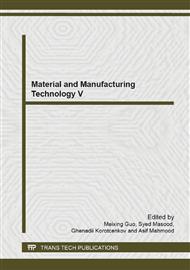[1]
I. Mukherjee and P. K. Ray, A review of optimization techniques in metal cutting processes, Computers & Industrial Engineering, vol. 50, no. 1–2, p.15–34, May (2006).
DOI: 10.1016/j.cie.2005.10.001
Google Scholar
[2]
R. Saravanan, P. Asokan, and M. Sachithanandam, Comparative Analysis of Conventional and Non-Conventional Optimisation Techniques for CNC Turning Process, The International Journal of Advanced Manufacturing Technology, vol. 17, no. 7, p.471–476, Apr. (2001).
DOI: 10.1007/s001700170146
Google Scholar
[3]
A. M. Zain and U. Teknologi, An overview of GA technique for Surface Roughness Optimization in Milling Process, Information Technology, vol. 4, Aug. (2008).
DOI: 10.1109/itsim.2008.4631925
Google Scholar
[4]
D. M. D'Addona and R. Teti, Genetic Algorithm-based Optimization of Cutting Parameters in Turning Processes, Procedia CIRP, vol. 7, p.323–328, Jan. (2013).
DOI: 10.1016/j.procir.2013.05.055
Google Scholar
[5]
A. M. Zain, H. Haron, and S. Sharif, Application of GA to optimize cutting conditions for minimizing surface roughness in end milling machining process, Expert Systems with Applications, vol. 37, no. 6, p.4650–4659, Jun. (2010).
DOI: 10.1016/j.eswa.2009.12.043
Google Scholar
[6]
M. D. Selvam, Optimization of machining parameters for face milling operation in a vertical cnc milling machine using genetic algorithm, Engineering Science and Technology, vol. 2, no. 4, p.544–548, (2012).
Google Scholar
[7]
J. S. Senthilkumaar, P. Selvarani, and R. M. Arunachalam, Intelligent optimization and selection of machining parameters in finish turning and facing of Inconel 718, The International Journal of Advanced Manufacturing Technology, vol. 58, no. 9–12, p.885–894, Jun. (2011).
DOI: 10.1007/s00170-011-3455-7
Google Scholar
[8]
C. Zhang and J. Chen, Methods of optimization of milling parameters based on genetic algorithm, 2009 9th International Conference on Electronic Measurement & Instruments, p.1–382–1–385, Aug. (2009).
DOI: 10.1109/icemi.2009.5274851
Google Scholar
[9]
P. Sahoo, Optimization of turning parameters for surface roughness using rsm and ga, Advances in production Engineering and management, vol. 6, p.197–208, (2011).
Google Scholar
[10]
A. Konak, D. W. Coit, and A. E. Smith, Multi-objective optimization using genetic algorithms: A tutorial, Reliability Engineering & System Safety, vol. 91, no. 9, p.992–1007, Sep. (2006).
DOI: 10.1016/j.ress.2005.11.018
Google Scholar
[11]
D. V. V. K. Prasad and K. Bharathi, Multi-Objective Optimization of Milling Parameters for Machining Cast Iron on Machining Centre, Research Journal of Engineering Sciences, vol. 2, no. 5, p.35–39, (2013).
Google Scholar


